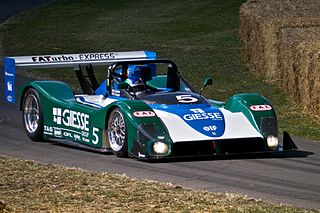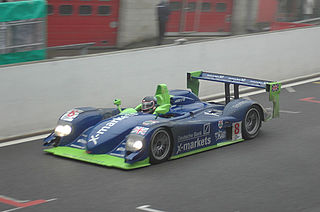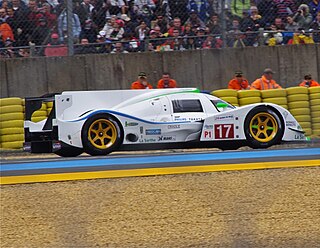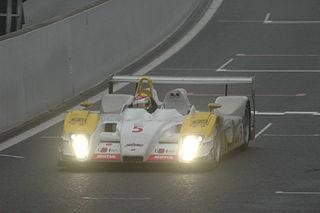Related Research Articles

The Ferrari 333 SP is a sports prototype race car that was built by Italian race car manufacturer Dallara and later Michelotto to compete in the World Sports Car championship for Ferrari. Unveiled at the end of 1993, at the behest of amateur racer Giampiero Moretti, the 333 SP marked Ferrari's official return to sports car racing after a 20-year absence. The car was built to compete in the IMSA's new WSC class, which replaced the previous GTP cars.

Judd is a brand of racing car engines built by Engine Developments Ltd., a company founded in 1971 by John Judd and Jack Brabham in Rugby, Warwickshire, England. Engine Developments was intended to build engines for Brabham's racing efforts, and became one of the first firms authorised by Cosworth to maintain and rebuild its DFV engines, but has since expanded into various areas of motorsport.

A Daytona Prototype is a type of sports prototype racing car developed specifically for the Grand American Road Racing Association's Rolex Sports Car Series as their top class of car, which replaced their main prototype racing class, specifically Le Mans Prototypes (LMPs). The cars later competed in the merged series of the WeatherTech SportsCar Championship, from 2014-2016, before being phased out and replaced by the Daytona Prototype International class in 2017. They are named after the main series event, the Rolex 24 at Daytona.
Advanced Engine Research, Ltd. is an auto racing engine manufacturer based in Basildon, Essex, England. Established in 1997, AER has developed winning engines for a number of high-profile international race series in sports car, prototype racing, rallying, touring car, and open wheel racing. They have designed engines derived from road car platforms, but their emphasis is on clean sheet designed engines with a focus on electronics and turbochargers. Their engines have raced in the 24 Hours of Le Mans, the World Endurance Championship (WEC), the European Le Mans Series (ELMS), the United SportsCar Championship (TUSC), GP3, British Touring Car Championship (BTCC), Nissan/Renault World Series, Grand-Am, Paris Dakar and FIA Sportscar Championship. They have worked with a number of manufacturers including Mazda, Ford, Hyundai, MG/Rover, Nissan, and Toyota. In 2012, AER developed and built Formula One turbo test engines to current rules and in July 2012, AER was chosen as engine partner and supplier to the new GP3 racing series.

The Dallara SP1, also known as the Chrysler LMP, was a Le Mans Prototype built by Italian firm Dallara. Initially used as part of Chrysler Corporation's attempt to win the 24 Hours of Le Mans, the cars were later sold to customers for use series such as the FIA Sportscar Championship and Le Mans Series.

The MG-Lola EX257 is a Le Mans Prototype built by Lola for the MG car company for their attempt to compete again at the 24 Hours of Le Mans in 2001. The car has had many years of mixed success since its introduction, even in privateer hands.
The Lola B98/10 was a Le Mans Prototype built by Lola Cars International for use in the International Sports Racing Series, American Le Mans Series, and 24 Hours of Le Mans. It would be the first international sports car built by Lola since they briefly left the sport in 1992 following the Lola T92/10. It would be succeeded in 2000 by the Lola B2K/10.

The Lola B2K/10 was a Le Mans Prototype developed in 2000 by Lola Cars International for use in the 24 Hours of Le Mans, American Le Mans Series, Grand American Road Racing Championship, and Sports Racing World Cup. It was a replacement for the previous Lola B98/10 and shared some elements with its smaller variant, the Lola B2K/40.

The Lola B2K/40 was a Le Mans Prototype developed in 2000 by Lola Cars International as a cheaper, smaller, and lighter alternative to the similar Lola B2K/10. Although specifically designed to compete in the SR2 class of the Sports Racing World Cup and Grand American Road Racing Championship, it would later be adapted to the LMP675 and LMP2 classes for the 24 Hours of Le Mans and American Le Mans Series. This design was replaced in 2005 by the Lola B05/40 and would last be used in competition in 2006.

The Riley & Scott Mark III was a sports prototype auto racing car developed by Bob Riley, Bill Riley, and Mark Scott of Riley & Scott Cars Inc. Initially designed in 1993, the car was created for the World Sports Car (WSC) category which was to debut in the North American IMSA GT Championship during their 1994 season. It was not until 1995 that the first Mk III was completed, but the construction of further cars allowed a variety of teams to campaign in several North American and European racing series, including competing at the 24 Hours of Le Mans.

The Audi R10 TDI, usually abbreviated to R10, is a diesel-powered racing car from the German car manufacturer Audi. The car dominated Le Mans, winning each year from its 2006 introduction until it was replaced by the R15 in 2009. It was designed and constructed for sports car racing in the Le Mans Prototype LMP1 class of the 24 Hours of Le Mans, and other similar endurance races. The car was unveiled December 13, 2005 at 12:00 CET, and went on to win both its maiden race at the 2006 12 Hours of Sebring in March, and the June 2006 24 Hours of Le Mans.
Crawford Composites is an American manufacturer of carbon fiber and composite parts company based in Denver, North Carolina. Crawford designs and manufacture structural and non-structural composite components in industries such as aerospace, aviation, motor sports, health care, defense and structural construction.
Andrew Thorby is a British racecar designer. Thorby designed many formula racing and Le Mans Prototype cars.

The Dome S102, later upgraded and raced as the Dome S102.5, is a sports prototype built and designed for use in the LMP1 class of the 24 Hours Of Le Mans, and other similar endurance races. The car is the successor to the Dome S101, and its later evolutions. The car was unveiled on 21 March 2008.

The Dome S101, later upgraded and raced as the Dome S101 Hb, S101 Hbi, and the Dome S101.5, is a sports prototype built and designed for use in the LMP1 class of the 24 Hours Of Le Mans, and other similar endurance races. The car was the predecessor to the Dome S102, and the Strakka-Dome S103. The car had its racing debut at the 2001 Barcelona 2 Hours and 30 minutes, the opening round of the 2001 FIA Sportscar Championship, with the Den Blå Avis racing team.
The Audi/Bentley 90° twin-turbocharged V8 racing engine is a 3.6-liter and 4.0-liter, twin-turbocharged, four-stroke, 90-degree, V8 racing engine, used in the Audi R8C, Audi R8R, Audi R8 and Bentley Speed 8 Le Mans Prototype race cars, between 1999 and 2005.
The Lola B99/00 is an open-wheel racing car chassis, designed and built by Lola Cars that competed in the CART open-wheel racing series, for competition in the 1999 season.

The Toyota 91C-V is a Group C sports prototype racing car, developed and built by Toyota intended to participate in the World Sportscar Championship, the 24 Hours of Le Mans, and the All-Japan Japanese Sports-Prototype Championship. It is an evolution of the previous 90C-V. Its powerplant is a turbocharged 3.2–3.6 L (200–220 cu in) Toyota V8 engine, producing 800 hp (600 kW). It won 3 races, achieved 6 podium finishes, and scored 3 pole positions. At a speed of 200 mph (320 km/h), it is capable of producing over 5,000 lbf (22,000 N) of downforce.
The Kudzu DG-1 is an IMSA GTP Lights sports prototype race car, designed, developed and built by American racing driver Jim Downing; making its debut in 1989. It competed in the IMSA GT Championship between 1989 and 1993. It was powered by either a Mazda 13B Wankel rotary engine, or a Buick V6 engine. Its best result was a 5th-place finish, and it achieved 4 class wins.
The Kudzu DG-2 is an IMSA GTP Lights sports prototype race car, designed, developed and built by American racing driver Jim Downing, to compete in sports car racing, between 1992 and 1999. It debuted at the 1992 12 Hours of Sebring. Its best result was a third-place race finish, and it achieved ten class wins. It was powered by a naturally-aspirated 3.4 L (210 cu in) Buick V6 engine. Only 3 models were manufactured and produced.
References
- ↑ "Mulsanne's Corner: 2001-2002 Crawford SSC2K". www.mulsannescorner.com.
- ↑ http://www.dlg.speedfreaks.org/archive/cars/crawford/autos/1403.php
- ↑ "Mulsanne's Corner: Engine Developments Judd GV4 V10". www.mulsannescorner.com.
- ↑ "Mulsanne's Corner: 2001-2002 Crawford SSC2K". www.mulsannescorner.com.
- ↑ "Andy Scriven". LinkedIn. Retrieved 21 June 2014.
- ↑ "2001-2002 Crawford SSC2K". Mulsanne's Corner.
- ↑ "Crawford SSC2K". Racing Sports Cars. Retrieved 20 June 2014.